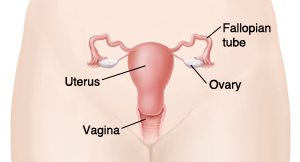Tubal Sterilization Surgery
Tubal sterilization is one of the most effective forms of birth control. It blocks the egg from being fertilized by sperm. This prevents pregnancy. The surgery can be an outpatient procedure or done after the birth of a child. It can be done at the time of delivery if you are having a cesarean section.

Making the decision
If you have tubal sterilization, you most likely will never get pregnant again. Be sure that’s what you want. Talk it over with your healthcare provider and your partner. Surgery to undo tubal sterilization is complicated. It's costly. And it's not always successful. So, think of tubal sterilization as a lifelong birth control choice.
Closing the tubes
Your healthcare provider will choose the best way to block your tubes. Tubes may be closed with heat (cauterization). They may be closed with a clip or ring. Or they may be tied off and cut.
Your surgery
Your healthcare provider will tell you your choices for how the surgery will be done. There are several choices for surgical sterilization. Your provider will also discuss with you the complete removal of the tubes as an added benefit to decreasing ovarian cancer risk.
|
Laparoscopy
|
Minilaparotomy
|
|
This surgery is done without a hospital stay. For the procedure, a laparoscope is used. This is a thin tube with a camera and a light on the end. The healthcare provider makes 1 to 2 small incisions in the stomach. The scope is put through one of the incisions. The scope sends live pictures of your fallopian tubes to a video screen. Surgical tools are placed through the other small incisions. Using the live images, the healthcare provider blocks your tubes. All tools are removed. The incisions are then closed with stitches or staples.
|
A small incision is made near the navel or at the pubic hairline. This surgery is often done right after childbirth. An incision is made just underneath the belly button. Just after childbirth your uterus is enlarged. So it's easier to locate the tubes from an incision near the navel than from an incision near the pubic bone. The healthcare provider works through this incision to block the tubes. The incision is then closed with stitches or staples. After a cesarean section delivery, the sterilization can be done through the existing incision.
|
© 2000-2024 The StayWell Company, LLC. All rights reserved. This information is not intended as a substitute for professional medical care. Always follow your healthcare professional's instructions.